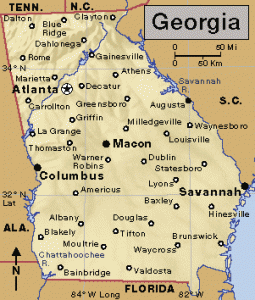 Atlanta is the capital and largest city of Georgia. It serves as a center of trade and transportation for the southeastern United States. More than 400,000 people live in the city, and the Atlanta metropolitan area has about 4 million people.
Atlanta is the capital and largest city of Georgia. It serves as a center of trade and transportation for the southeastern United States. More than 400,000 people live in the city, and the Atlanta metropolitan area has about 4 million people.
Atlanta is known for its rolling hills and beautiful dogwood blossoms. It lies in northern Georgia, in the foothills of the Blue Ridge Mountains.
In 1837, a town called Terminus was founded at what is now Atlanta. The town soon developed into a busy trade and transportation center. In 1845, it was renamed Atlanta. During the American Civil War (1861-1865), Atlanta served as a Confederate supply depot. Union troops led by General William T. Sherman captured the city in 1864 and burned most of its buildings.
Click here for maps, jobs, shopping, nightlife and anything else in Atlanta!
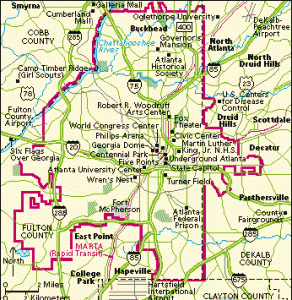 Layout of Atlanta
Layout of Atlanta
Atlanta has had several periods of industrial expansion and construction growth. Today, it is the center of one of the fastest-growing U.S. urban areas.
Atlanta covers 132 square miles (342 square kilometers). The Chattahoochee, one of Georgia’s major rivers, forms part of the city’s western border. Most of Atlanta lies in Fulton County, but its easternmost section extends into DeKalb County.
Downtown Atlanta is a bustling area in the east-central part of the city. It has a mix of modern office towers and mid-rise buildings that date from the late 1800’s and early 1900’s. The traditional heart of downtown is an intersection called Five Points, which has a cluster of banks, department stores, and office buildings. To the east is Auburn Avenue, the location of the Martin Luther King, Jr., National Historic Site. The site honors King, who was born in Atlanta and became a famous civil rights leader. It includes King’s birthplace; the Ebenezer Baptist Church, where King preached; and the King Center, which houses his tomb. The State Capitol-which dates from 1889-and other government buildings stand near Five Points. Underground Atlanta, a 22-acre (9-hectare) shopping and entertainment complex lies below street level just south of Five Points.
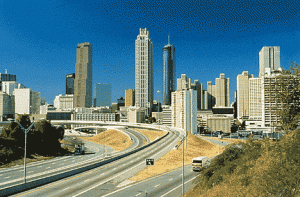 Atlanta’s most famous street, Peachtree, runs from downtown northward to residential areas. It is the site of Peachtree Center, a modern downtown business complex that includes hotels, office buildings, restaurants, shops, and convention and entertainment facilities. Also to the north of downtown is Atlanta’s tallest building, the 1,023-foot (312-meter) Bank of America Plaza. Other landmarks include the cylinder-shaped Westin Peachtree Plaza, which is the tallest hotel in the Western Hemisphere; and the Fox Theater, a grand movie house that dates from 1929.
Atlanta’s most famous street, Peachtree, runs from downtown northward to residential areas. It is the site of Peachtree Center, a modern downtown business complex that includes hotels, office buildings, restaurants, shops, and convention and entertainment facilities. Also to the north of downtown is Atlanta’s tallest building, the 1,023-foot (312-meter) Bank of America Plaza. Other landmarks include the cylinder-shaped Westin Peachtree Plaza, which is the tallest hotel in the Western Hemisphere; and the Fox Theater, a grand movie house that dates from 1929.
Residential areas spread out beyond the downtown region. Industrial activity is scattered throughout the area, most heavily in the south.news, classifieds, jobs and home information, click here!
The metropolitan area
Atlanta’s metropolitan area spreads out over 20 counties and covers 6,126 square miles (15,866 square kilometers). It is home of about half of Georgia’s people.
Most of the metropolitan area population is concentrated in five counties-Clayton, Cobb, DeKalb, Fulton, and Gwinnett. Sandy Springs, Atlanta’s largest suburb, lies north of the city. Other large suburbs include East Point, Marietta, Roswell, and Smyrna.
Atlanta’s suburban areas offer many historical sites as well as new housing developments and large business districts. At least two business complexes rival those within the city limits and are anchored by major shopping malls. The malls are Cumberland Mall/Galleria Mall in Cobb County and Perimeter Mall in DeKalb County. The metropolitan area also offers beautiful scenery the year around. Popular recreation areas near Atlanta include the Blue Ridge Mountains and Lake Sidney Lanier, both north of the city.
People
Ethnic groups. African Americans make up Atlanta’s largest single ethnic group. They account for about 61 percent of the city’s population. In the entire metropolitan area, whites make up about 63 percent of the population and African Americans about 29 percent. The largest white groups include people of British, German, and Irish ancestry. Asians and Hispanics represent small but growing parts of the area’s population.
Housing. Atlanta is famous for its large, single-family houses with beautiful flower gardens and dogwood blossoms. The Druid Hills area is one of the nation’s oldest planned suburban neighborhoods. It was designed in 1903 by American landscape architect Frederick Law Olmsted and Atlanta businessman Joel Hurt. The neighborhood is known for its large houses, broad front lawns, and curving streets shaded by towering trees. Other suburbs also include luxurious neighborhoods.
Substandard housing is a problem in some older neighborhoods in poor areas of the central city, especially those south of downtown. A number of private organizations, including Georgia-based Habitat for Humanity, run programs to assist in renovating or building houses for the poor.
Education
The Atlanta metropolitan area has about 700 public schools that serve about 500,000 students. The largest school systems are those of DeKalb and Cobb counties. About 36,000 students attend approximately 185 church-supported and other private schools in the Atlanta area.
Atlanta has about 35 accredited colleges and universities. The largest are Georgia State University and the Georgia Institute of Technology, often called Georgia Tech. The Atlanta University Center is the largest complex of predominantly African American colleges and universities in the United States. It consists of Clark Atlanta University; Morehouse, Morris Brown, and Spelman colleges; and the Interdenominational Theological Center. Located just outside the city limits, Emory University is recognized for its medical research programs. Other institutions of higher learning in the area include Agnes Scott College and Columbia Theological Seminary in Decatur, Kennesaw State University in Kennesaw, and West Georgia College in Carrollton.
Cultural life
The arts. The Atlanta Ballet, founded in 1929, is the oldest regional ballet company in the United States. It performs in the Atlanta Civic Center. The Civic Center also hosts summer musicals produced by Theater of the Stars. The Robert W. Woodruff Arts Center houses the Alliance Theater Company, the Atlanta Symphony, and the Atlanta College of Art. Clayton State College in Morrow offers performances by the Thamyris chamber music ensemble at Spivey Hall. Suburban playhouses include the Neighborhood Playhouse in Decatur and the Theater in the Square in Marietta.
Museums and libraries
Collections at the High Museum of Art emphasize European and American paintings and sculptures from the 1800’s and 1900’s. The museum is part of the Robert W. Woodruff Arts Center. Other art museums in Atlanta include the Hammonds House Galleries and Resource Center for African-American Art and the Michael C. Carlos Museum at Emory University. Atlanta’s public library system has a downtown facility and about 25 branches.
The Atlanta Historical Society complex houses a museum and a library of local history. The Fernbank Science Center includes a planetarium and a forest preserve. Wren’s Nest, the home of journalist Joel Chandler Harris, is now a museum. Harris is famous for his “Uncle Remus” stories, published in the late 1800’s.
The Carter Presidential Center stands on a hill overlooking downtown Atlanta. This large complex houses the Jimmy Carter Library and the Carter Center of Emory University. The library contains items associated with Carter’s term as president of the United States. The Carter Center of Emory University is a research institute that deals with international affairs.
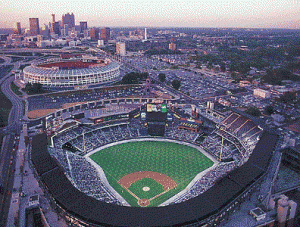 Recreation
Recreation
The Atlanta area has hundreds of parks. Piedmont Park, which opened in 1895, hosts the Atlanta Arts Festival each fall. The festival features art exhibits, concerts, and dance programs. A series of roadside parks near suburban North Druid Hills was designed by Frederick Law Olmsted. Grant Park includes the Atlanta Zoo and the Cyclorama, a circular painting of the Battle of Atlanta of 1864. The Cyclorama, housed around a moving platform,measures 42 feet (13 meters) high and 358 feet (109 meters) in circumference.
Atlanta has a number of professional sports teams. The city is the home of the Atlanta Falcons of the National Football League, the Atlanta Braves baseball team of the National League, the Atlanta Hawks of the National Basketball Association, and the Atlanta Thrashers of the National Hockey League.
Economy
The Atlanta metropolitan area is a center for service industries. It ranks as a leader in wholesale and retail trade, transportation, and communication. Service-related jobs employ about 447,000 of the area’s people. Manufacturing employs about 195,000 people.
Service industries. Atlanta has a thriving wholesale trade industry. Much of this trade takes place in the huge downtown Merchandise Mart. Numerous large retail trade centers serve both Atlantans and visitors.
Atlanta is a transportation and communication hub. Hartsfield International Airport in College Park ranks among the world’s busiest airports for passenger and cargo flights. Delta Air Lines is headquartered in Atlanta. The city is also the chief railroad center of the Southeast. United Parcel Service (UPS), the largest U.S. package delivery company, has its headquarters in Atlanta. Two major communications companies headquartered in Atlanta are the Cable News Network (CNN) and BellSouth. A number of daily newspapers serve the area. The major paper is The Atlanta Journal-Constitution.
Government services also contribute to Atlanta’s economy. The Georgia state government, based in Atlanta, employs many people. A number of federal government agencies also have offices in the area. The U.S. Centers for Disease Control and Prevention (CDC) maintains its headquarters just outside the city limits and has many laboratories in Atlanta. Military installations in the area include Fort McPherson south of downtown, Fort Gillem near Forest Park, and the Atlanta Naval Air Station and Dobbins Air Force Base near Marietta.
Manufacturing
The chief manufactured products of the Atlanta area include food, transportation equipment, tobacco products, electronics, and textiles. The Coca-Cola Company has its headquarters in Atlanta. Lockheed Martin Aeronautical Systems, which manufactures military planes, is near Marietta.
Government
Atlanta has a mayor-council form of government. The city’s voters elect the mayor, the city council president, and the 18 members of the council to four-year terms. The Atlanta area has over 60 other local government bodies, including county and city governments, local boards of education, and a regional transit authority.
History
Early days. The Creek Indians inhabited the Atlanta area before whites reached the region. In 1813, the U.S. Army sent troops commanded by Lieutenant George R. Gilmer to the area to build a fort about 7 miles (11 kilometers) northwest of present-day downtown Atlanta. The fort stood along the Chattahoochee River at a site known as Standing Peachtree. It became an important trading post. In 1837, the Western and Atlantic Railroad selected a site at what is now Atlanta for the end of a new rail line. A town called Terminus was established at the site. It was renamed Marthasville in 1843. In 1845, the town sought a new name. J. Edgar Thompson, a railroad engineer, suggested the name Atlanta. Some people say the name is a feminine version of Atlantic from the Western and Atlantic Railroad. Others say it is a feminine version of Atlantis, a legendary lost continent.
Atlanta was chartered as a city in 1847. Fulton County was established in 1853, with Atlanta as the county seat. After the American Civil War began in 1861, Atlanta’s central location and its railroad network made it a main shipping point for Confederate supplies. In 1864, Union troops led by General William T. Sherman captured Atlanta and burned most of it to the ground. Fewer than 400 of the city’s approximately 3,700 buildings were left standing.
After the Civil War ended in 1865, Atlanta was quickly rebuilt. It replaced Milledgeville as the state capital in 1868. By 1880, Atlanta had over 37,000 residents and ranked as Georgia’s largest city. In 1881, it held the International Cotton Exposition to focus attention on its potential as a manufacturing center. The city’s Cotton States and International Exposition of 1895 included an exhibit on the progress made by blacks since the Civil War. The popular soft drink Coca-Cola was invented in Atlanta in 1886. By 1900, Atlanta had become an important manufacturing and retailing center and had nearly 90,000 residents.
In 1906, a race riot between blacks and whites resulted in 12 deaths and numerous injuries. Afterward, city leaders established a committee to promote racial tolerance. The riot resulted in black businesses moving away from the central business district to Auburn Avenue. Auburn Avenue gradually became an important street for black businesses and black churches.
Gate City of the South. In 1917, a fire destroyed about 2,000 buildings in Atlanta. The city was again quickly rebuilt. By 1920, Atlanta’s 14 rail lines and 4 major railroads earned it the name Gate City of the South. Through a promotional campaign, the Atlanta area attracted hundreds of new businesses. In 1936, the nation’s first federally funded low-income housing project, Techwood Homes, was opened in Atlanta.
The mid-1900’s. World War II brought new military installations and industries to Atlanta. In 1943, the area’s first naval air station opened on the site of what is now DeKalb-Peachtree Airport, near Chamblee. Many farmworkers moved to the Atlanta area to work in war industries and remained after the war ended in 1945. By 1950, about 330,000 people lived in the city, and the metropolitan area had grown to about 727,000. In 1952, Atlanta annexed 81 square miles (210 square kilometers) of suburban land to the north, west, and south of the city, adding about 100,000 residents to its population.
The 1960’s marked a period of major growth for Atlanta. The area’s first expressways were completed in the late 1950’s and early 1960’s. Atlanta-Fulton County Stadium, finished in 1965, became the home of the city’s first major league sports team, the Braves.
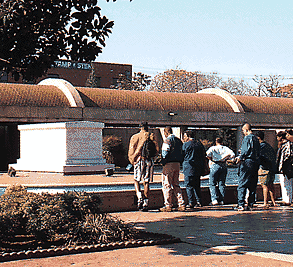 During the 1960’s, Atlanta became known as one of the most racially progressive cities inthe South. It was a center of leadership for the civil rights movement. Martin Luther King, Jr., and others founded the Southern Christian Leadership Conference (SCLC) in Atlanta in 1957 to coordinate the work of civil rights groups. Under Mayor Ivan Allen, Jr., who held office from 1962 to 1969, Atlanta peacefully integrated its public schools. An alliance of white business leaders and influential members of the black community helped accomplish this change. In 1969, Atlanta voters elected Sam Massell, Jr., a white, as mayor, and Maynard Jackson, a black, as vice mayor. Jackson was elected mayor in 1973. He became the first black mayor of a major Southern city. He was reelected in 1977.
During the 1960’s, Atlanta became known as one of the most racially progressive cities inthe South. It was a center of leadership for the civil rights movement. Martin Luther King, Jr., and others founded the Southern Christian Leadership Conference (SCLC) in Atlanta in 1957 to coordinate the work of civil rights groups. Under Mayor Ivan Allen, Jr., who held office from 1962 to 1969, Atlanta peacefully integrated its public schools. An alliance of white business leaders and influential members of the black community helped accomplish this change. In 1969, Atlanta voters elected Sam Massell, Jr., a white, as mayor, and Maynard Jackson, a black, as vice mayor. Jackson was elected mayor in 1973. He became the first black mayor of a major Southern city. He was reelected in 1977.
The late 1900’s. Andrew Young, also a black, was elected to succeed Jackson in 1981 and was reelected in 1985. Jackson was elected mayor again in 1989. In 1993, Bill Campbell, another black, was elected to succeed Jackson. He won reelection in 1997.
Atlanta’s city population reached its highest level, about 495,000, in 1970. In the next two decades, the movement of many Atlantans to the suburbs helped cause the city’s population to decrease to about 394,000 by 1990. However, the move to the suburbs and an increase of the size of the metropolitan area helped the metropolitan population soar from about 1,600,000 in 1970 to about 4 million in 2000.
Major construction has continued in Atlanta. The Omni International Complex, a recreational and commercial center, opened in 1975. In 1986, Atlanta businessman Ted Turner bought the complex and renamed it the CNN Center after his Cable News Network (CNN). The Georgia World Congress Center, a state-owned convention center, was completed in 1976. The NationsBank Plaza (now the Bank of America Plaza) opened in 1992. The Underground Atlanta shopping and entertainment complex opened in 1989, and the Georgia Dome in 1992. In 1996, Atlanta hosted the Summer Olympic Games. More construction took place to prepare for the event. A stadium was built downtown to be used for Olympic events and afterward-in 1997-it became the new home of the Braves. A new park, Centennial Olympic Park, was created downtown.
Contributor: Brian P. O’Shea, M.A., Content Manager, Inside Central Florida.

